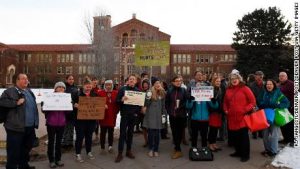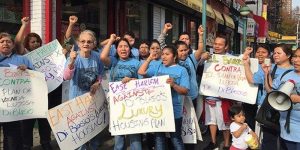
DENVER CO – JANUARY 15: Teachers at South High School picket, before school starts, asking for a wage increase on January 15, 2019 in Denver, Colorado. Bargaining negotiations between Denver Public Schools and the teacher’s union carry on this week with a vote at the end of the week to determine whether Denver teachers will strike. (Photo by RJ Sangosti/The Denver Post)
By evaluating how two educational organizing entities utilize social justice unionism, I hope to delve deeper into mobilizing efforts that target funding inequalities. Social justice organizing highlights the voice of a community alongside grassroots organizing to change public policy or matters affecting that community. The National Association of Education Activists released an article covering social justice unionism and its seven components: defending the rights of members and the broader community, incorporating community groups, uniting the staff members at a school, putting teachers at the center of school reform agenda, nurture reflective and active citizenry, advocate for a restructuring of American education and educate and mobilize for social justice in all areas of society (1994). Looking at my topic, I want to highlight uniting staff members, putting teachers at the center of the school reform agenda, and advocating for a restructuring of American education.

Base-building for Social Justice Organizing: Getting Our Communities Involved in the Fight! Coco Organizing. (2017).
Social justice unionism creates a community and an outlet for joining together educators across schools, and districts. This can be incredibly powerful as it encourages educators to take ownership, while also uniting the union to other entities of the community such as churches, advocacy groups, or political and business spaces. This type of organizing also asks educators to take ownership and to promote racial and gender equity in school reforms. Activist Lois Weiner states that in social justice unionism, “member’s self-interests are broadly defined – going beyond immediate economic and contractual concerns” (2012, p. 39). Teachers have a voice for their own interests, but also those of their students. A social justice union puts educators at the forefront of reform and allows them to move beyond typical union interests to attack underlying problems; such as the movement from fair pay to equitable funding policies or racial equity.

Education Austin Social Justice Caucus. Facebook. (2020).
Another form of organizing is social justice caucuses. In her dissertation, Lauren Stark lists how rank-and-file educators democratically transform unions and advance justice in society and schools through building collective power by forming caucuses (2019). Active and engaged educators in caucus leadership urge union transformation to incorporate more social justice initiatives. The creation of a social justice caucus also reinforces the vision of equity and change in the union and communities at large.
